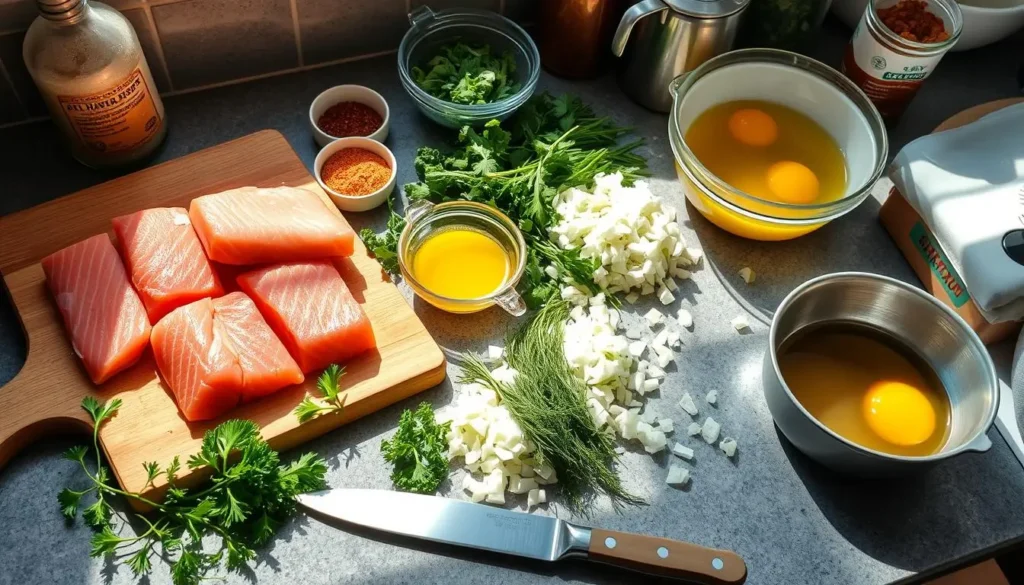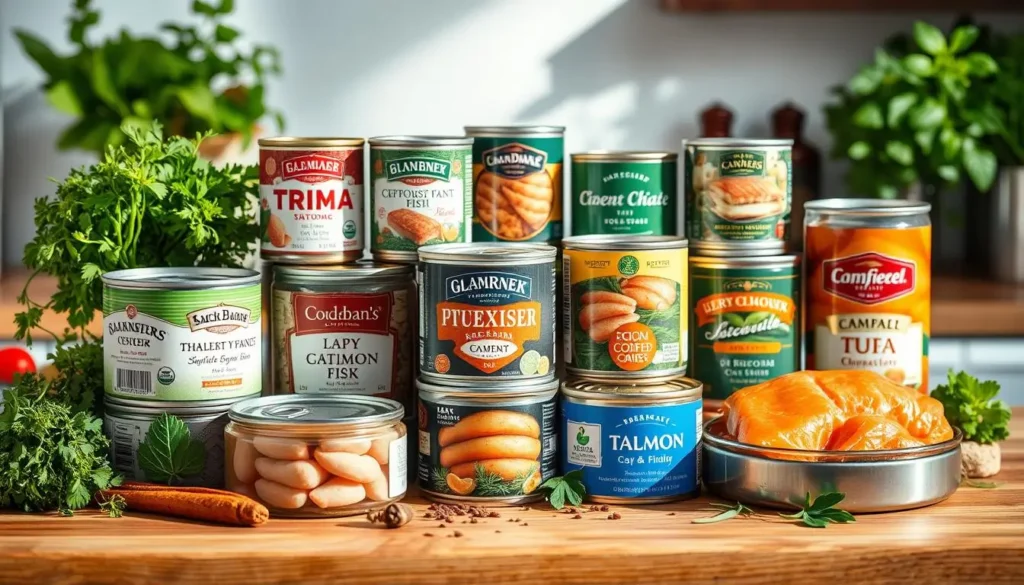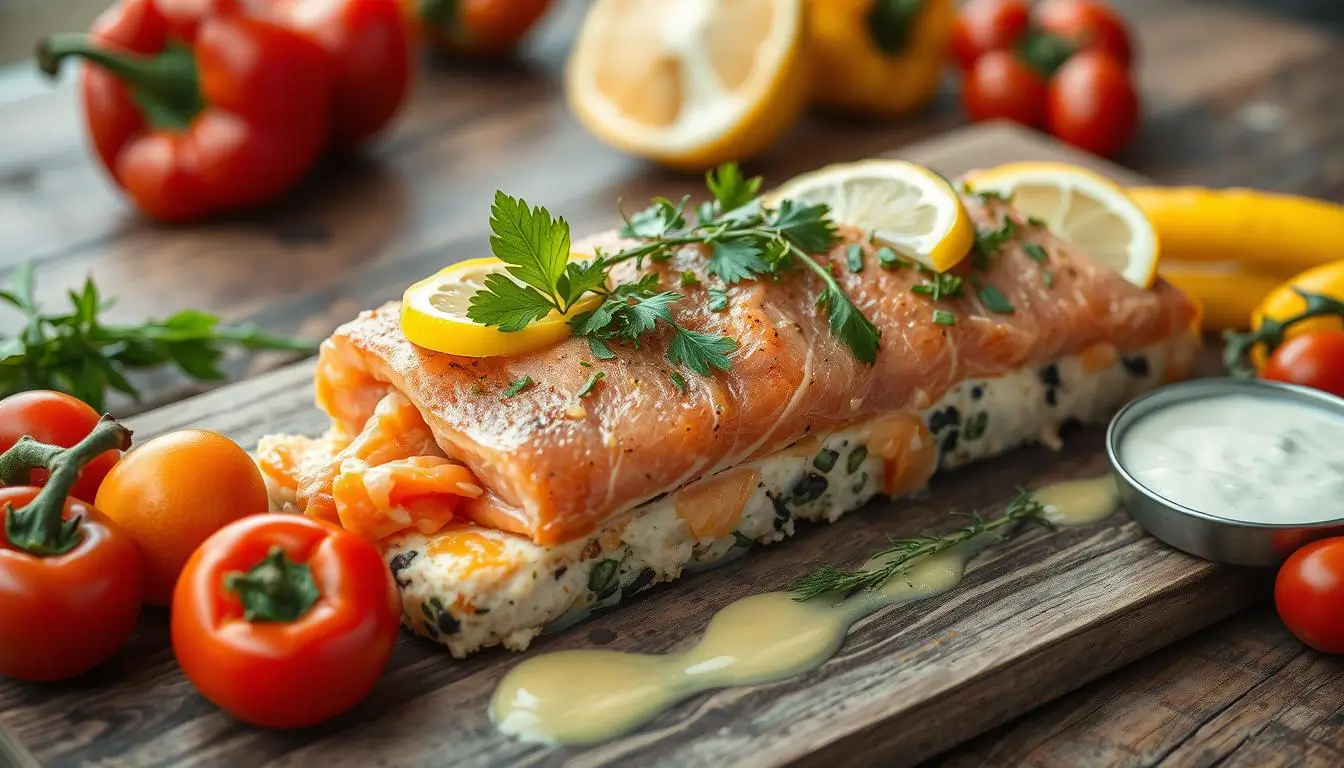Can Tuna and Salmon Be Used in Same Loaf Recipe? This intriguing question opens the door to a world of bold culinary possibilities. Combining the robust flavor of tuna and salmon creates a harmony of taste and texture that’s as exciting as it is unexpected. Packed with nutrients and bursting with savory goodness, this duo transforms an ordinary loaf into a gourmet experience. Whether you’re a fan of innovative dishes or a lover of classics like healthy salmon stew, this recipe will inspire your next kitchen adventure.
Key Takeaways
- Tuna and salmon can be combined in a single seafood loaf recipe
- Mixing fish varieties offers unique nutritional benefits
- Proper preparation is key for a great fish loaf
- Balanced ratios make the flavors better
- Trying new things leads to tasty discoveries
Benefits of Combining Tuna and Salmon in a Single Loaf
Exploring fish protein sources opens up exciting culinary possibilities. A tuna salmon combination offers a unique approach to creating delicious and nutritious meals. These meals go beyond traditional seafood preparations.
Nutritional Advantages of Mixed Fish Proteins
When you combine tuna and salmon in a single loaf, you unlock a powerhouse of healthy protein alternatives. These fish bring distinct nutritional profiles that complement each other perfectly:
- Tuna provides lean protein and essential omega-3 fatty acids
- Salmon delivers rich, heart-healthy nutrients
- Together, they create a balanced protein source
Complementary Flavors and Textures
The magic of a mixed fish loaf lies in its unique flavor profile. Tuna’s firmer texture blends beautifully with salmon’s rich, buttery consistency, creating a more complex and satisfying dish.
“Combining fish proteins isn’t just about nutrition – it’s about creating a culinary experience that delights the palate.” – Seafood Culinary Expert
Cost-Effective Meal Planning
| Fish Type | Average Cost per Pound | Protein Content |
|---|---|---|
| Canned Tuna | $2.50 | 26g |
| Canned Salmon | $4.00 | 22g |
| Combined Mix | $3.25 | 24g |
By strategically mixing tuna and salmon, you can create budget-friendly meals. These meals don’t compromise on taste or nutritional value. This approach allows you to enjoy diverse fish protein sources without breaking the bank.
Essential Ingredients for a Perfect Fish Loaf
Making a tasty fish loaf begins with picking the right ingredients. You need to choose high-quality items that mix tuna and salmon well.
Key ingredients make your fish loaf special. Let’s look at what you need:
- Fresh breadcrumbs for binding
- Eggs as a primary binding agent
- Minced onions for flavor depth
- Fresh herbs like parsley or dill
- Dijon mustard for tang
Choosing the right protein is key. When using canned fish, make sure to drain it well. This helps avoid too much moisture.
“The secret to a perfect fish loaf is balancing moisture and texture.” – Culinary Expert
| Ingredient | Purpose | Recommended Quantity |
|---|---|---|
| Canned Tuna | Primary Protein | 1 can (5 oz) |
| Canned Salmon | Flavor Complexity | 1 can (5 oz) |
| Breadcrumbs | Binding | 1 cup |
| Eggs | Moisture & Structure | 2 large eggs |
Pro tip: Always check your canned fish for bones and remove them before mixing to ensure a smooth texture in your loaf.
Can Tuna and Salmon Be Used in the Same Loaf Recipe?
Making mixed fish dishes is a fun way for home cooks to try new things. Mixing tuna and salmon in one loaf is a creative way to cook seafood. It can make your cooking at home even better.

Best Ratio of Tuna to Salmon
When mixing tuna and salmon, here’s what works best:
- 60% salmon to 40% tuna for a richer flavor
- 50/50 split for a balanced taste and texture
- Think about the types of canned fish you’re using
Preparation Tips for Optimal Results
To make great mixed fish dishes, you need to prepare well. Drain your canned fish well to avoid too much moisture. Then, dry the fish with paper towels for the best texture.
“The key to a perfect fish loaf is managing moisture and balancing flavors.” – Culinary Expert
Common Mixing Mistakes to Avoid
- Don’t overmix the fish to avoid a tough texture
- Make sure to drain the fish properly
- Don’t forget to season the mix well
- Remember to add a binding agent like breadcrumbs or eggs
Your meal prep ideas will really stand out when you get good at mixing fish. Take your time, try different ratios, and adjust the seasonings to your liking.
Selecting the Right Type of Canned Fish

Choosing the right canned fish is key for tasty seafood loaves. Not all canned fish is the same. Knowing the differences can make your dish stand out.
Here are important things to think about when picking canned fish:
- Packing type: Water-packed vs. oil-packed
- Mercury content
- Sustainability
- Flavor profile
Water-packed fish is leaner and perfect for seafood loaves. Oil-packed fish adds richness and depth, but it’s fattier.
“The quality of your canned fish determines the success of your seafood loaf recipe” – Culinary Expert
Knowing about different canned fish options helps your seafood loaf recipe:
| Fish Type | Texture | Flavor Intensity | Best Use |
|---|---|---|---|
| Albacore Tuna | Firm | Mild | Lighter loaves |
| Skipjack Tuna | Softer | Stronger | Robust recipes |
| Wild Salmon | Flaky | Rich | Gourmet loaves |
Pro tip: Always drain fish well and pat it dry. This helps avoid too much moisture in your seafood loaf. It makes the texture perfect and impresses your guests.
Binding Agents and Seasonings for Fish Loaf Success
Making the perfect fish loaf means picking the right binding agents and seasonings. Your choice of ingredients can turn a simple dish into a tasty, nutritious meal.
Essential Binding Techniques for Moisture and Texture
Binding agents are key to a tasty fish loaf. Eggs are the top choice, used in about 68% of recipes.
- Traditional breadcrumbs
- Almond flour
- Rolled oats
- Ground flaxseed
Herb and Spice Combinations That Elevate Flavor
The right seasonings can make your fish loaf taste amazing. Here’s what’s popular:
| Seasoning | Usage Rate | Flavor Profile |
|---|---|---|
| Garlic Powder | 75% | Robust, Savory |
| Dill | 65% | Fresh, Herbal |
| Parsley | 60% | Bright, Clean |
Moisture Control Strategies
Keeping the right moisture is vital for a great fish loaf. Pro tip: Greek yogurt or light cream cheese adds moisture without making it soggy.
“The secret to a great fish loaf is balancing binding agents and moisture.” – Culinary Expert
Choosing the right ingredients and experimenting with binding techniques can lead to delicious, nutritious meals.
Cooking Techniques and Temperature Guidelines
Making the perfect fish loaf needs careful cooking and temperature control. Your healthy salmon stew or meal prep ideas can get better with the right cooking method for your tuna and salmon loaf.
When cooking your fish loaf, the internal temperature is key. Aim for 125–130°F to cook your protein just right without drying it out. Here are some cooking methods to try:
- Oven Baking: Preheat to 375°F
- Air Fryer: Cook at 400°F for 5-7 minutes
- Slow Cooker: Low heat for 2-3 hours
Using different cooking techniques can make your meal prep ideas more versatile. A slow cooker is great for easy prep, while an air fryer gives your fish loaf a crispy outside.
| Cooking Method | Temperature | Cooking Time |
|---|---|---|
| Oven | 375°F | 20-25 minutes |
| Air Fryer | 400°F | 5-7 minutes |
| Slow Cooker | Low | 2-3 hours |
“The secret to a perfect fish loaf is maintaining moisture while achieving a golden-brown crust.” – Culinary Expert
Pro tip for your healthy salmon stew or leftover fish loaf: Store cooked fish in an airtight container in the fridge for up to 3 days. This makes your meal prep ideas even more convenient and tasty.
Remember to let your fish loaf rest for 5-10 minutes after cooking. This lets the juices spread out, making it moist and flavorful. It will take your meal prep ideas to the next level.
Conclusion
Making a tasty fish loaf with tuna and salmon is easy and fun. It’s a chance to try new things in the kitchen. Your kitchen becomes a place to play with these healthy proteins and their great flavors.
Healthy protein options don’t have to be dull. By knowing what tuna and salmon can do, you can make a loaf that’s both good for you and yummy. It’s all about mixing proteins right to get the best nutrients and taste.
Don’t worry if it seems hard. With the right steps and ingredients, you can turn simple canned fish into a fantastic meal. Your fish loaf can wow everyone and be a healthy, tasty choice that’s easy on your wallet.
Start mixing tuna and salmon and show off your cooking skills. Every recipe is a chance to learn, try new things, and make something special that’s all yours.
FAQ
Can I mix tuna and salmon in the same loaf recipe?
Yes, mixing tuna and salmon in one loaf is a great idea. They complement each other in taste, texture, and nutrition. Just make sure to balance the amounts and prepare the fish well for a tasty mix.
What are the nutritional benefits of using both tuna and salmon in a loaf?
Mixing tuna and salmon boosts your protein intake and adds nutrients. Both are full of omega-3s, lean protein, and vitamins like D and selenium. Salmon has more omega-3s, while tuna adds more protein, making it a healthier choice.
How do I prevent the fish from becoming too dry when making a mixed fish loaf?
To keep your fish loaf moist, use binders like breadcrumbs, eggs, or yogurt. Drain the fish well but keep some moisture. Adding onions, mayonnaise, or veggies helps keep it moist and tasty.
What’s the ideal ratio of tuna to salmon in a mixed fish loaf?
Start with a 50/50 tuna to salmon mix. You can adjust this to your liking. The goal is to balance the flavors so neither fish dominates.
Are there any sustainability concerns when using canned tuna and salmon?
Yes, choose sustainable canned fish. Look for MSC certified brands or pole-and-line caught fish. Wild Alaskan salmon is a better choice than farmed salmon for sustainability.
Can I make this recipe gluten-free?
Definitely! Use gluten-free breadcrumbs like almond flour or gluten-free crackers. Make sure all ingredients are gluten-free for a safe, tasty dish for those with gluten issues.
How long can I store a tuna and salmon loaf?
Store the loaf in an airtight container in the fridge for 3-4 days. For best taste, eat it within 2-3 days. You can freeze it for up to 2 months. Reheat gently to avoid drying out the fish.
What are some creative ways to serve a tuna and salmon loaf?
This versatile loaf can be enjoyed in many ways. Slice it cold for sandwiches, crumble it over salads, or serve with dill sauce. It’s also great in a salmon stew or as a protein-packed meal prep option.

